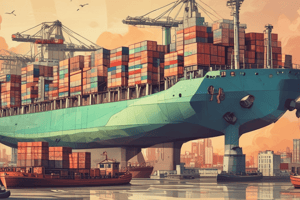Podcast
Questions and Answers
What is the hallmark of merchant capitalism during the Industrial Revolution?
What is the hallmark of merchant capitalism during the Industrial Revolution?
- Exporting finished goods and importing raw materials (correct)
- Importing finished goods and exporting raw materials
- Amassing wealth through importing raw materials
- Mass production of raw materials
Which concept involves connecting firms in different countries with each participant contributing unique skills and resources?
Which concept involves connecting firms in different countries with each participant contributing unique skills and resources?
- Market Segmentation
- Global Value Chains (correct)
- Trade Finance
- Supply Chain Management
What strategy involves analyzing competitive dynamics to achieve sustainable advantages over competitors?
What strategy involves analyzing competitive dynamics to achieve sustainable advantages over competitors?
- Consumer Behavior Analysis
- Competitive Strategy (correct)
- Trade Finance
- Supply Chain Management
What practice involves identifying and reaching specific groups of potential customers for tailored marketing messages?
What practice involves identifying and reaching specific groups of potential customers for tailored marketing messages?
Which trend in future commerce landscapes could revolutionize payments through decentralized blockchain technology?
Which trend in future commerce landscapes could revolutionize payments through decentralized blockchain technology?
Flashcards are hidden until you start studying
Study Notes
Discovering Commerce: A Modern Guide
Commerce is a dynamic force shaping our global society, connecting people through trade and fostering economic growth. This comprehensive guide will take you on a journey of understanding commerce's core concepts and its transformations throughout history up until modern times.
Defining Commerce
In simple terms, commerce refers to exchanging goods, services, or information between individuals, businesses, or countries with the goal of creating value and generating profit. It involves the production, distribution, exchange, and consumption of various items within complex networks of buyers, sellers, suppliers, and consumers worldwide.
Evolution of Commerce
Throughout history, different forms of commerce have evolved, each driven by significant advancements in technology, transportation, and communication systems. These changes transformed how we buy, sell, and interact with one another economically:
- Barter System: Early human societies relied on direct bartering before transitioning into using commodity money like salt, shells, or cowry shells.
- Agricultural Trade: Advances in agriculture enabled ancient civilizations to produce surplus foodstuffs, ushering in long-distance trade routes along rivers and across continents.
- Industrial Revolution and Merchantilism: In the 18th century, industrialization led to mass production, giving rise to merchant capitalism characterized by nation states amassing wealth through exporting finished goods and importing raw materials.
- Retail Transformation: From traditional corner stores and mail order catalogues to supermarkets and shopping malls, new retail formats emerged during the 20th century—all paving the way towards today’s online marketplaces.
- Emergence of E-commerce and Globalized Markets: As technological innovations grew in sophistication, so too did digital markets, enabling everyone from major corporations down to individual entrepreneurs to reach customers around the globe.
Key Concepts in Contemporary Commerce
To fully grasp contemporary commerce, it's essential to understand several key concepts such as:
- Supply Chain Management: The process of planning, controlling, executing, analyzing, and monitoring all activities involved in sourcing raw materials, manufacturing products, storing them securely, distributing them to customers, selling, and collecting payment.
- Global Value Chains: Complex structures that connect firms located in multiple countries, where every participant contributes unique skills and resources that lead to the final product.
- Market Segmentation and Target Marketing: The practice of identifying and reaching specific groups of potential customers in order to offer tailored marketing messages and more personalized experiences.
- Trade Finance: Various financial instruments used in international trade transactions, including letters of credit, documentary collections, and bonds, helping facilitate cross-border commerce.
- Consumer Behavior Analysis: Examining factors influencing consumer decisions to develop strategies aimed at enhancing sales volume and revenue.
- Competitive Strategy: Analyzing competitive dynamics and formulating business tactics designed to achieve sustainable advantages over competitors.
Future Trends in Commerce
As the world continues evolving rapidly, several trends are likely to shape future commerce landscapes:
- Digital Currencies and Cryptocurrencies: Rapid expansion of digital currencies based on decentralized blockchain technology could potentially revolutionize payments and monetary systems.
- Automated Supply Chain Processes: Increased automation could increase operational efficiency while reducing costs and minimizing errors.
- Sustainability Focused Practices: Companies shifting their focus toward sustainability initiatives through circular economy principles, reducing waste, and promoting environmentally friendly practices.
- Omnichannel Retailing Strategies: Integrating physical and digital touchpoints to deliver seamless customer journeys and improve brand loyalty.
- Artificial Intelligence Applications: Advanced AI technologies supporting supply chain management, predictive analytics, and customized experiences for end users.
- Regulatory Changes and Compliance Standards: Adapting to emerging regulations and compliance standards related to data privacy, cybersecurity, and environmental concerns.
This foundational knowledge provides a strong basis for understanding the role commerce plays in driving global economies forward while constantly addressing challenges posed by rapid technological innovation, changing customer needs, and increasing competition. By recognizing these elements, you can better prepare yourself to navigate the exciting landscape of contemporary commerce.
Studying That Suits You
Use AI to generate personalized quizzes and flashcards to suit your learning preferences.




